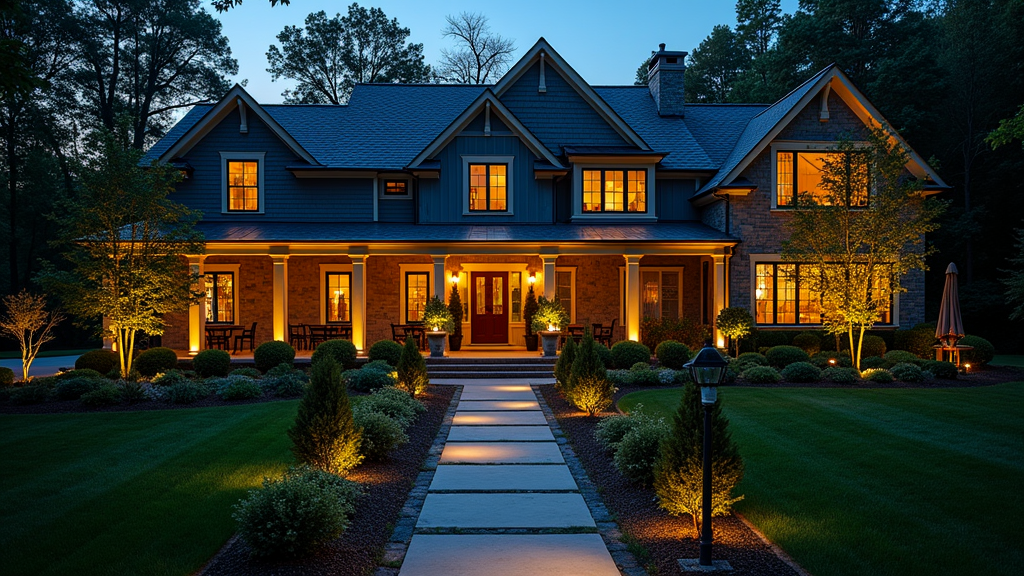Introduction
Outdoor lighting is an art and science that transforms not just the landscape but also enhances architectural features beautifully. Imagine a stunning home facade illuminated against the night sky, cast in warm hues that highlight its unique designs and textures. That's the magic of properly executed outdoor lighting! In this comprehensive guide, we delve into how to highlight architectural features with outdoor lights, ensuring your space becomes a visual delight after sundown.
Understanding Landscape Lighting
What is Landscape Lighting?
Landscape lighting refers to the use of various types of lights strategically placed in outdoor spaces to enhance visibility and create ambiance. It encompasses everything from garden lights to pathway illumination, including the vital task of accentuating architectural structures.
Why is Landscape Lighting Important?
Not only does landscape lighting improve safety by illuminating pathways and entrances, but it also adds aesthetic appeal. By strategically highlighting architectural features, you can create focal points that draw the eye and enhance your property's overall design.
Selecting Outdoor Lighting Types
Types of Outdoor Lights Available
When diving into landscape lighting, you'll find a plethora of options available:
- Spotlights: Ideal for highlighting specific features like sculptures or unique architectural elements. Floodlights: Great for broader illumination; perfect for expansive areas. Path Lights: Designed for walkways, these lights ensure safe navigation while adding charm. Wall Washers: Excellent for casting light up or down walls to emphasize textures.
Choosing the Right Type for Your Needs
Understanding what you want to highlight will guide you in selecting the right type of light. For instance, if you have a beautiful stone wall, wall washers can bring out its texture effectively.
How to Highlight Architectural Features with Outdoor Lights
Architectural features such as columns, arches, and textured walls deserve special attention when planning your outdoor lighting strategy. Here’s how you can do it effectively:
Identify Key Features: Take note of what aspects of your architecture are most appealing—perhaps it's a grand entrance or intricate details on your porch.
Layer Your Lighting: Use a combination of ambient, task, and accent lighting. Ambient lighting provides general illumination; task lighting helps with activities like reading on a patio; accent lighting draws attention to specific features.
Positioning is Key: Place lights at angles that best showcase your architectural details. For example, placing floodlights at ground level directed upwards can dramatically illuminate columns or textured walls.
Consider Light Color Temperatures: Warmer tones tend to be more inviting and can evoke feelings of comfort—ideal for residential settings.
Use Dimmers and Timers: Control how bright or dim your fixtures are depending on the occasion; this adds versatility to your outdoor space.
Best Practices for Landscape Lighting Design
Create Depth with Layered Lighting
Creating depth involves using various light intensities and types at different heights. A well-thought-out arrangement not only illuminates but also creates drama through shadows—highlighting textures while also crafting an inviting atmosphere.
Maintain Balance in Light Distribution
Avoid overly bright spots next to dark areas; balance is crucial for achieving that professional look in outdoor settings. Consider using multiple fixtures rather than one powerful source of light.
Choosing the Right Fixtures for Outdoor Spaces
Material Choices Matter
Your choice of fixture material will determine longevity and performance under weather conditions:

- Aluminum: Lightweight yet durable; resistant to rust. Stainless Steel: Offers modern aesthetics with excellent durability. Copper: Develops a beautiful patina over time but may require more maintenance.
Style Considerations for Fixtures
Match your fixture style with your architecture—contemporary homes may benefit from sleek designs while traditional homes might suit ornate fixtures better.
Energy Efficiency in Outdoor Lighting Solutions
LED vs. Halogen: Which is Better?
LED lights consume less power compared to halogen bulbs while lasting significantly longer—making them an eco-friendly choice that saves money over time without sacrificing brightness or quality!
Common Mistakes When Installing Outdoor Lighting
Overlighting Specific Areas: Too much light can create harshness rather than beauty; moderation is key. Ignoring Seasonal Changes: Plan for seasonal variations in daylight hours. Neglecting Maintenance Needs: Ensure easy access for bulb changes and cleaning fixtures regularly.Lighting Trends Worth Considering
Smart Technology Integration in Outdoor Lighting
From smart timers to motion sensors, integrating technology into your landscape lighting enhances convenience while providing energy savings!
FAQs About Outdoor Architectural Lighting
What are the best types of lights for highlighting architectural features?- Spotlights and wall washers are excellent choices as they allow precise targeting on specific details.
- Walk around your property at night; identify focal points you wish to highlight then plan accordingly based on visibility!
- Yes! However, if you're dealing with electrical work or complex installations, hiring professionals may be prudent.
- Warm white (2700K) creates an inviting atmosphere suitable for residential environments.
- Absolutely! Solar-powered lights are energy-efficient but may need placement adjustments based on sun exposure throughout the day.
- LED bulbs typically last 15 years or more depending on usage while halogen bulbs usually last about 2 years.
Conclusion: The Last Word on Architectural Features Highlighting with Outdoor Lights
In closing, knowing how to highlight architectural features with outdoor lights not only elevates the beauty of your property but brings warmth and safety into nighttime https://anotepad.com/notes/byaast82 spaces as well! Whether you're showcasing elegant columns or unique angles in modern design, thoughtful application will yield stunning results that captivate both residents and visitors alike!
So go ahead—embrace these tips! Create layers of light that play upon surfaces beautifully while adding dimension to every corner outside your home! With a little creativity combined with strategic planning (and perhaps some expert advice), you'll soon see just how enchanting well-lit architecture can truly be!